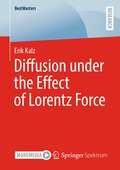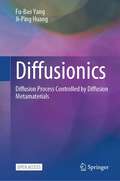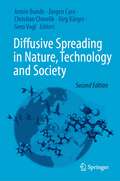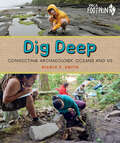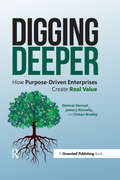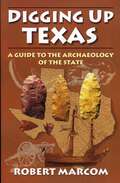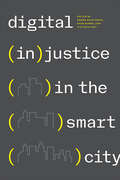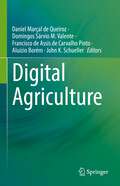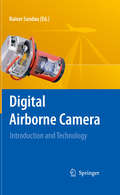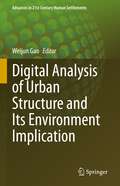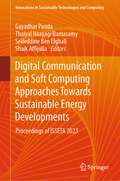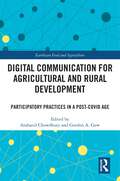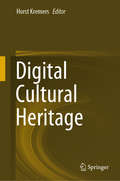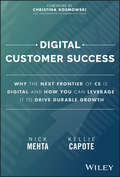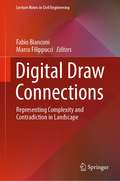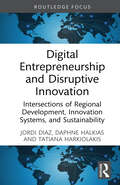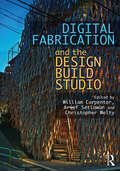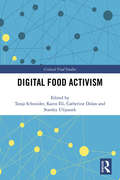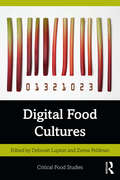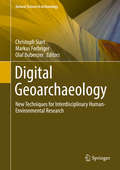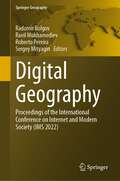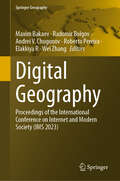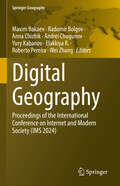- Table View
- List View
Diffusion under the Effect of Lorentz Force (BestMasters)
by Erik KalzIt is generally believed that collisions of particles reduce the self-diffusion coefficient. In this book, Erik Kalz shows that in classical systems under the effect of Lorentz force, which are characterized by diffusion tensors with antisymmetric elements, collisions surprisingly can enhance self-diffusion. In these systems, due to an inherent curving effect, the motion of particles is facilitated, instead of hindered by collisions. Consistent with this the author finds that the collective diffusion remains unaffected. Using a geometric model, he theoretically predicts a magnetic field governed crossover from a reduced to an enhanced self-diffusion. The physical interpretation is quantitatively supported by the force autocorrelation function, which turns negative with increasing the magnetic field. Using Brownian-dynamics simulations, he validates the predictions.
Diffusionics: Diffusion Process Controlled by Diffusion Metamaterials
by Ji-Ping Huang Fu-Bao YangThis open access book presents a comprehensive exploration of diffusion metamaterials that control energy and mass diffusion. Currently, if from the perspective of governing equations, diffusion metamaterials and wave metamaterials (pioneered by J. B. Pendry in the 1990s) are recognised as the two most prominent branches in the field of metamaterials. These two branches differ in their emphasis on the diffusion equation (as the governing equation) and time-dependent characteristic lengths in diffusion metamaterials, as opposed to the wave equation (as the governing equation) and time-independent characteristic lengths in wave metamaterials. Organized into three distinct parts – 'Thermal Diffusion Metamaterials', 'Particle Diffusion Metamaterials', and 'Plasma Diffusion Metamaterials' – this book offers a rigorous exploration spanning physics, engineering, and materials science, aimed at advancing our understanding of diffusion processes controlled by diffusion metamaterials. Incorporating foundational theory, computational simulations, and laboratory experiments, the book equips researchers and scholars across these disciplines with comprehensive methods, insights, and results pivotal to the advancement of diffusion control. Beyond facilitating interdisciplinary discourse, the book serves as a catalyst for innovative breakthroughs at the crossroads of physics, thermodynamics, and materials science. Essentially, readers will acquire profound insights that empower them to spearhead advancements in diffusion science (diffusionics) and the engineering of metamaterials.
Diffusive Gradients in Thin-Films for Environmental Measurements (Cambridge Environmental Chemistry Series)
by William DavisonThe diffusive gradients in thin-films (DGT) technique is a means of measuring the concentration and speciation of metals in natural waters. Edited by one of the pioneers of the technique, this unique volume provides a complete and authoritative guide to the theory and applications of DGT. The book includes explanations of the fundamental principles of DGT, accessible to readers with a modest background in chemistry, as well as more advanced chapters that provide a thorough treatment of the physical and chemical dynamics of this technique and evaluate how well it mimics the biological uptake process. Chapters on natural waters, soils and sediments illustrate the applications of DGT, and detailed instructions are included on how to use DGT in practice. Combining the fundamentals of DGT with more advanced principles, this is an indispensable text for students, researchers and professional scientists interested in the chemistry of natural waters, soils and sediments. Provides a coherent and detailed account of the applications and uses of this valuable technique, ensuring that readers are fully initiated into all aspects of this emerging tool Edited by a world-leading expert on DGT, ensuring firsthand information and accurate, up-to-date research Includes a chapter on practical uses of DGT encouraging the reader to master this technique themselves, aiding the readers' own research and furthering their understanding of these processes on a practical level
Diffusive Spreading in Nature, Technology and Society
by Armin Bunde Jörg Kärger Jürgen Caro Gero Vogl Christian ChmelikWhat do the movements of molecules and the migration of humans have in common? How does the functionality of our brain tissue resemble the flow of traffic in New York City? How can understanding the spread of ideas, rumors, and languages help us tackle the spread a pandemic? This book provides an illuminating look into these seemingly disparate topics by exploring and expertly communicating the fundamental laws that govern the spreading and diffusion of objects. A collection of leading scientists in disciplines as diverse as epidemiology, linguistics, mathematics, and physics discuss various spreading phenomena relevant to their own fields, revealing astonishing similarities and correlations between the objects of study—be they people, particles, or pandemics.This updated and expanded second edition of an award-winning book introduces timely coverage of a subject with the greatest societal impact in recent memory—the global fight against COVID-19. Winner of the 2019 Literature Prize of the German Chemical Industry Fund, this book targets an interdisciplinary readership, featuring an introductory chapter that sets the stage for the topics discussed throughout. Each chapter provides ample opportunity to whet the appetite of those readers seeking a more in-depth treatment, making the book also useful as supplementary reading in appropriate courses dealing with complex systems, mass transfer, and network theory.
Dig Deep: Connecting Archaeology, Oceans and Us (Orca Footprints #25)
by Nicole F. SmithKey Selling Points This book looks at how we can learn from the past to help our oceans today and into the future. It draws on recent archaeological findings from around the world and engages readers in a variety of STEAM topics. The book emphasizes the importance of honoring Indigenous Traditional Knowledge in our understanding of the past and present. It highlights examples of Indigenous cultural heritage and shows young readers that there are many ways of knowing and understanding the world around us. Invites kids to ask questions about their archeological footprint, how it affects the world’s oceans and what it can tell us about the effects of climate change. The author is a working archaeologist with over 20 years of experience and a focus on clam gardens, fish traps, stone tools, archaeological sites over 10,000 years old, and the effects of climate change and sea-level rise on cultural heritage. Dig Deep was read by a number of expert readers, including archaeologists and an Indigenous authenticity reader to ensure it reflected Indigenous ways of knowing.
Digging Deeper: How Purpose-Driven Enterprises Create Real Value
by Dietmar Sternad James J. Kennelly Finbarr BradleyWhat is the primary purpose of business? The standard answer is ‘making profits,’ but some visionary entrepreneurs and leaders fundamentally disagree. Instead of just making money, they choose instead to “dig deeper” and make a difference through creating real value – improving the lives of others even as they find deeper meaning in their own. These leaders build enterprises that provide identity and a sense of purpose, create positive relationships and a place to learn and thrive, embed sustainability in all that they do, and strive to improve the quality of life of all of their stakeholders. Although not their primary focus, they also make healthy profits, as their unique approach to value creation provides them with a sustainable competitive edge.Digging Deeper is a book full of inspiring stories that illustrate that there is an alternative to a myopic and narrow capitalism that trades in inequalities, exploitation, collective burnout and negative consequences for our shared natural environment. Remarkable examples from all over the world vividly demonstrate how enterprises can create real value through focusing on what the authors call the 6 Ls: long-term orientation, lasting relationships, local roots, limits recognition, developing a learning community and taking leadership responsibility seriously in its very best sense.Digging Deeper liberates the term “value” from the tight chains in which the global financial community has bound it and demonstrates that businesses can contribute to a better life for all ‒ if their leaders can go beyond viewing enterprises as single-purpose money-making machines and develop purpose-driven enterprises that create real value for all.
Digging Up Texas: A Guide to the Archaeology of the State
by Robert MarcomTake a guided tour of more than 15,000 years of life in TexasMr. Marcom has authored a volume that makes the incredibly diverse archaeological record of Texas accessible to interested laypersons and beginning avocational archaeologists.
Digital (Technoscience and Society)
by Debra Mackinnon Ryan Burns Victoria FastIn the contemporary moment, smart cities have become the dominant paradigm for urban planning and administration, which involves weaving the urban fabric with digital technologies. Recently, however, the promises of smart cities have been gradually supplanted by recognition of their inherent inequalities, and scholars are increasingly working to envision alternative smart cities. Informed by these pressing challenges, Digital (In)Justice in the Smart City foregrounds discussions of how we should think of and work towards urban digital justice in the smart city. It provides a deep exploration of the sources of injustice that percolate throughout a range of sociotechnical assemblages, and it questions whether working towards more just, sustainable, liveable, and egalitarian cities requires that we look beyond the limitations of "smartness" altogether. The book grapples with how geographies impact smart city visions and roll-outs, on the one hand, and how (unjust) geographies are produced in smart pursuits, on the other. Ultimately, Digital (In)Justice in the Smart City envisions alternative cities – smart or merely digital – and outlines the sorts of roles that the commons, utopia, and the law might take on in our conceptions and realizations of better cities.
Digital Agriculture
by Aluízio Borém Daniel Marçal de Queiroz Domingos Sárvio M. Valente Francisco de Assis de Carvalho Pinto John K. SchuellerThis textbook addresses the most recent advances and main digital technologies used in farming. The reader will be able to understand the main concepts and techniques currently used to efficiently manage agricultural production systems. The book covers topics in a general and intuitive way, with examples and good illustrations.
Digital Airborne Camera
by Rainer SandauDigital airborne cameras are now penetrating the fields of photogrammetry and remote sensing. Due to the last decade's results in research and development in the fields of for instance detector technology, computing power, memory capacity position and orientation measurement it is now possible to generate with this new generation of airborne cameras different sets of geometric and spectral data with high geometric and radiometric resolutions within a single flight. This is a decisive advantage as compared to film based airborne cameras. The linear characteristic of the opto-electronic converters is the basis for the transition from an imaging camera to an images generating measuring instrument. Because of the direct digital processing chain from the airborne camera to the data products there is no need for the processes of chemical film development and digitising the film information. Failure sources as well as investments and staff costs are avoided. But the effective use of this new technology requires the knowledge of the features of the image and information generation, its possibilities and its restrictions. This book describes all components of a digital airborne camera from the object to be imaged to the mass memory device. So the image quality influencing processes in nature are described, as for instance the reflection of the electromagnetic sun spectrum at the objects to be imaged and the influence of the atmosphere. Also, the essential features of the new digital sensor system, their characteristics and parameters, are addressed and put into the system context. The complexity of the cooperation of all camera components, as for instance optics, filters, detector elements, analogue and digital electronics, software and so forth, becomes transparent. The book includes also the description of example systems.
Digital Analysis of Urban Structure and Its Environment Implication (Advances in 21st Century Human Settlements)
by Weijun GaoThis book provides new information to understand the relationship between urban development and environmental change to the reader. How to create a sustainable and livable urban environment and realize the sustainable development goals (SDGs) of the United Nations (UN) is one of the biggest challenges in this century, even in the next centuries. The covered subject areas of this book aim at finding a way to push SDGs forward by collecting the related knowledge between urban development and its environmental implication. Specifically, the book focuses on UN SDGs 9 (industry, innovation and infrastructure), 11 (sustainable cities and communities), and 13 (climate action). Regarding the SDGs 9, this book assesses urban population mobility, urban ecosystem services, and green infrastructure to address climate change in cities. Regarding the SDGs 11, this book explores the sustainability of urban landscape change associated with urbanization based on a multi-scale perspective. Regarding the SDGs 13, this book explores the issues affecting the development of healthy cities in the context of climate change and possible ways to address them. This book focuses on newer fields related to various forms of urbanization and urban climate. Under different urbanization and development scenarios, the city and built environment are facing new challenges and become a major concern. Better understandings of related physical laws and sustainable technologies are badly needed. This book is a good reference to urban planners, city officials, citizens who are concerned about the city environment, and policymakers, as well as students studying urban structure and environment.
Digital Communication and Soft Computing Approaches Towards Sustainable Energy Developments: Proceedings of ISSETA 2023 (Innovations in Sustainable Technologies and Computing)
by Gayadhar Panda Seifeddine Ben Elghali Thaiyal Naayagi Ramasamy Shaik AffijullaThis book is a second volume and contains selected papers presented at Second International Symposium on Sustainable Energy and Technological Advancements (ISSETA 2023), organized by the Department of Electrical Engineering, NIT Meghalaya, Shillong, India, during 24 – 25 February 2023. The topics covered in the book are the cutting-edge research involved in sustainable energy technologies, smart buildingtechnology, integration and application of multiple energy sources; advanced power converter topologies and their modulation techniques; and information and communication technologies for smart microgrids.
Digital Communication for Agricultural and Rural Development: Participatory Practices in a Post-COVID Age (Earthscan Food and Agriculture)
by Gordon A. GowThis volume presents insights on the challenges of digital communication and participation in agricultural and rural development. The COVID-19 pandemic has revealed that digital technology and mediated participation is more important and essential in managing ongoing communication for development projects than ever before. However, it has also underscored the various challenges and gaps in knowledge with digital participatory practices, including the further exclusion of marginalized groups and those with limited access to digital technology. The book considers how the concept of participation has been transformed by the realities of the pandemic, reflecting on essential principles and practical considerations of communication for development and social change, particularly in the context of global agriculture and food security, the well-being of rural communities, and evolving environmental challenges, such as climate change. In gathering these insights, this volume highlights lessons for the future of participatory development in communication for development and social change processes. This volume will be of great interest to students and scholars of agricultural and rural development, communication for development, digital communication, and sustainable development more broadly.
Digital Cultural Heritage
by Horst KremersThis book provides an overview of various application spheres and supports further innovations needed in information management and in the processes of knowledge generation. The professions, organizations and scientific associations involved are unusually challenged by the complexity of the data situation. Cartography has always been the central field of application for georeferencing digital cultural heritage (DCH) objects. It is particularly important in enabling spatial relation analysis between any number of DCH objects or of their granular details. In addition to the pure geometric aspects, the cognitive relations that lead to knowledge representation and derivation of innovative use processes are also of increasing importance. Further, there is a societal demand for spatial reference and analytics (e.g. the extensive use of cognitive concepts of "map" and "atlas" for a variety of social topics in the media). There is a huge geometrical-logical-cognitive potential for complex, multimedia, digital-cultural-heritage databases and stakeholders expect handling, transmission and processing operations with guaranteed long-term availability for all other stakeholders. In the future, whole areas of digital multimedia databases will need to be processed to further our understanding of historical and cultural contexts. This is an important concern for the information society and presents significant challenges for cartography in all these domains.This book collects innovative technical and scientific work on the entire process of object digitization, including detail extraction, archiving and interoperability of multimedia DCH data.
Digital Customer Success: Why the Next Frontier of CS is Digital and How You Can Leverage it to Drive Durable Growth
by Nick Mehta Kellie CapoteAutomate your Customer Success efforts to reduce churn and increase profits In Digital Customer Success: The Next Frontier, a team of trailblazing Customer Success professionals and digital entrepreneurs delivers an insightful discussion of the next stage in Customer Success management. In the book, you'll discover how to design and deploy touchless and automated digital interventions that help your software users learn and grow as they use your product and unlock the value trapped within it — without ever needing to reach out to a live Customer Success Manager. The authors provide a detailed “How-To” guide to Digital Customer Success that explains how you can meet the needs of your customers, investors, and team members. You'll explore the basics of the authors' original Digital Customer Success Maturity Model and the core tenets of how to get started. After that, you'll find: Explanations of the ideal organizational structures to enable Digital Customer Success management Case studies and examples from real companies blazing new trails in Customer Success Critical success measurements and metrics you can use to determine if your company is on the right track or if it needs to reorient Perfect for managers, executives, directors, founders, entrepreneurs, and other business leaders involved in the sale of digital and software products, Digital Customer Success is also a can't-miss resource for Customer Success professionals, sales leaders, marketers, product development professionals, and anyone else with a stake in reducing customer churn and increasing revenues.
Digital Draw Connections: Representing Complexity and Contradiction in Landscape (Lecture Notes in Civil Engineering #107)
by Fabio Bianconi Marco FilippucciThis book stems from the seminal work of Robert Venturi and aims at re-projecting it in the current cultural debate by extending it to the scale of landscape and placing it in connection with representative issues. It brings out the transdisciplinary synthesis of a necessarily interdisciplinary approach to the theme, aimed at creating new models which are able to represent the complexity of a contradictory reality and to redefine the centrality of human dimension. As such, the volume gathers multiple experiences developed in different geographical areas, which come into connection with the role of representation. Composed of 43 chapters written by 81 authors from around the world, with an introduction by Jim Venturi and Cezar Nicolescu, the volume is divided into two parts, the first one more theoretical and the other one which showcases real-world applications, although there is never a total split between criticism and operational experimentation of research.
Digital Dreams, Urban Realities: Crafting Sustainable, Inclusive, and Beautiful Cities (The Urban Book Series)
by Milena Vukmirović Aleksandra Đukić Eva Vaništa Lazarević Aleksandra Krstić-FurundžićThis book is a forward-thinking exploration of the future of urban development. This insightful book dives deep into how cities can evolve to become more sustainable, resilient, and inclusive by applying the innovative principles of the New European Bauhaus. By blending science, technology, art, and culture, the book provides a holistic view of ecological transition, offering fresh perspectives on urban challenges. It draws on a rich collection of real-world case studies, showcasing how these cutting-edge ideas are already being applied in cities across the globe. Each case study brings theory to life, providing actionable strategies that urban planners, architects, policymakers, and researchers can use to make a tangible impact in their own communities. A key highlight of the book is its emphasis on the importance of community involvement in urban planning. It explores how participatory design ensures that cities are not just built for people, but by people, creating spaces that reflect the diverse needs and aspirations of local populations. In addition, this book explores the role of education in preparing the next generation of urban thinkers. It introduces innovative curricula designed to equip future architects, planners, and policymakers with the skills they need to lead the ecological transition. With an international focus, the book draws on examples from diverse regions, giving readers a global perspective on sustainable development. Whether you're looking to implement greener building practices, foster community engagement, or innovate within urban design, this book offers valuable insights and practical tools for making cities not just livable, but truly thriving. This book is an essential read for anyone invested in the future of urban living. Ready to be part of the movement towards sustainable, beautiful, and inclusive cities? This book is your guide to turning that vision into reality
Digital Entrepreneurship and Disruptive Innovation: Intersections of Regional Development, Innovation Systems, and Sustainability (Routledge Focus on Business and Management)
by Daphne Halkias Jordi Diaz Tatiana HarkiolakisA new generation of entrepreneurs are leveraging artificial intelligence, data analytics, the Internet of Things (IoT) and other revolutionary technologies for greater social and environmental good. These digital entrepreneurs are developing disruptive solutions to the most pressing sustainability challenges of our time. Yet, behind every case of a successful digital entrepreneur is a wider network of governments, startup incubators and accelerators, incumbent firms, universities and other actors that form a regional entrepreneurial ecosystem.Through in-depth case studies, this book explores how digital entrepreneurs across various geographic regions use disruptive innovation within their regional entrepreneurial ecosystems to leverage digital technologies that create and develop novel business solutions crucial to meeting the United Nations’ Sustainable Development Goals. Exploring the perspectives of digital entrepreneurs themselves, each chapter in this book presents a case study that reveals how cultural differences and local socio-economic factors enable digital entrepreneurship driven by disruptive innovation.This book offers insights and recommendations through the stories of digital entrepreneurs across geographic regions for researchers, graduate students, practitioners and public- and private-sector leaders on harnessing the combined power of disruptive innovation and regional entrepreneurial ecosystems to fuel regional economic growth and sustainable development.
Digital Fabrication and the Design Build Studio
by William Carpenter Arief Setiawan Christopher WeltyThis book explores the connection between digital fabrication and the design build studio in both academic and professional studios.The book presents 17 essays and cases studies from well-known scholars and practitioners, including Kengo Kuma, Joseph Choma, Dan Rockhill, Keith Zawistowski, and Marie Zawistowski, whose theoretical and practical work addresses design build at various levels. Four introductory essays trace the history of the design build movement, exploring the emergence of design build in the pedagogy of the Bauhaus, the integration of technology into architectural design, and the influence of the act of making on the design build studio. The rest of the book is divided into two parts; the first part looks at traditional pedagogical models for the design build studio, and the second part focuses on experimental methods used in design build programs. Together, these works discuss human behavior, social-cultural trends, and motivations in socially minded studios which are based on a service-learning model. They look at component-based studios where innovation allows for an increased level of research and testing of new materials and assemblies, sustainable principles, and zero-energy prototypes.Illustrated with over 200 color images, this book will be a valuable resource for architecture students, educators, and practitioners seeking to explore the impact of digital fabrication on the global design build movement.
Digital Food Activism (Critical Food Studies)
by Stanley Ulijaszek Catherine Dolan Tanja Schneider Karin EliDigital Food Activism is a new edited volume that investigates how digital media technologies are transforming food activism and consumers' engagements with food, eating, and food systems. Bringing together critical food studies, economic anthropology, digital sociology, and science and technology studies, Digital Food Activism offers innovative multi-disciplinary analyses of food activist practices on social media, mobile apps, and hybrid online and offline alternative spaces. With chapters that focus on diverse digital platforms, food-related issues, and geographic locales, this volume reveals how platforms, programmers, and consumers are becoming key mediators of the mandate of food corporations and official governing actors. Digital Food Activism thereby suggests that emerging forms of activism in the digital era hold the potential to reshape the ethics, aesthetics, and patterns of food consumption.
Digital Food Cultures (Critical Food Studies)
by Deborah Lupton Zeena FeldmanThis book explores the interrelations between food, technology and knowledge-sharing practices in producing digital food cultures. Digital Food Cultures adopts an innovative approach to examine representations and practices related to food across a variety of digital media: blogs and vlogs (video blogs), Facebook, Instagram, YouTube, technology developers’ promotional media, online discussion forums and self-tracking apps and devices. The book emphasises the diversity of food cultures available on the internet and other digital media, from those celebrating unrestrained indulgence in food to those advocating very specialised diets requiring intense commitment and focus. While most of the digital media and devices discussed in the book are available and used by people across the world, the authors offer valuable insights into how these global technologies are incorporated into everyday lives in very specific geographical contexts. This book offers a novel contribution to the rapidly emerging area of digital food studies and provides a framework for understanding contemporary practices related to food production and consumption internationally.
Digital Geoarchaeology
by Olaf Bubenzer Christoph Siart Markus ForbrigerModern archaeology can be considered as an interdisciplinary approach that increasingly combines different methods and datasets to answer questions about ancient cultures and their remains. Having its major focus on new technologies and multi-method research approaches, the book promotes interdisciplinary studies between different disciplines such as archaeology, computer sciences, geography, geoinformatics, geodesy, history, etc. Common fields of work as well as future challenges are identified and discussed from different scientific perspectives. Each chapter starts with a general introduction to the topic followed by case studies. By stimulating knowledge transfer and collaboration, Digital Geoarchaeology contributes to an effective protection of cultural heritage and a better understanding of ancient landscapes along with their forming processes. This book includes topics and applications such as geographic and archaeological information systems, remote sensing, e. g. satellite imagery, aerial photographs, terrestrial and airborne laser scanning, digital image processing and pattern recognition, digital elevation models, 3D and 4D visualization and landscape reconstruction, geophysical prospecting, e. g. ERT, SRT, GPR as well as spatiotemporal analysis.
Digital Geography: Proceedings of the International Conference on Internet and Modern Society (IMS 2022) (Springer Geography)
by Radomir Bolgov Roberto Pereira Ravil Mukhamediev Sergey MityaginThis proceedings book presents select papers from the International Conference on Internet and Modern Society (IMS 2022). It discusses topical issues of digital geography and the geography of the information society, especially in urban settings. Participants from all over the world consider the controversies and challenges posed by globalization, focusing on Digital Urbanism, Smart Cities, Digital Sustainability, Social Media Movements, Digital Divide, and Cyber Psychology. The book will be of interest to academics, researchers, and students in digital humanities, as well as governmental and non-governmental cybersecurity organizations.
Digital Geography: Proceedings of the International Conference on Internet and Modern Society (IMS 2023) (Springer Geography)
by Wei Zhang Andrei V. Chugunov Radomir Bolgov Roberto Pereira Maxim Bakaev Elakkiya RThis proceedings book collects contributions from the Internet and Modern Society conference in 2023. The gathering addresses topical issues of digital geography and geography of information society, providing a platform for discussion and collaboration between experts in related fields. Participants from all over the world consider the controversies and challenges posed by globalization, focusing on topics including digital urbanism, smart cities, digital sustainability, social media movements, digital divides, cyber-psychology. This volume centers on five core themes: the digital city; computational linguistics and machine learning; interactive systems and information society technologies; cyberpsychology, digital health and active aging; and e-governance and political communication.
Digital Geography: Proceedings of the International Conference on Internet and Modern Society (IMS 2024) (Springer Geography)
by Wei Zhang Radomir Bolgov Yury Kabanov Roberto Pereira Andrei Chugunov Maxim Bakaev Elakkiya R. Anna ChizhikThis proceedings book collects contributions from the Internet and Modern Society conference in 2024. The gathering addresses topical issues of digital geography and the geography of information society, providing a platform for discussion and collaboration between experts in related fields. Participants from all over the world consider the controversies and challenges posed by digital technologies in society. This volume centers on three core themes: interactive systems and information-society technologies, e-governance and political communication, and art and innovation in museums.
